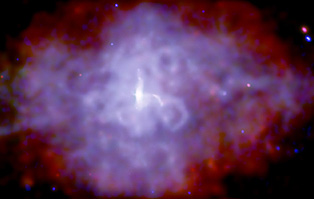Charlie Plain, NASA

Pictured: This photograph of the pulsar 3C58 was taken by the X-ray Chandra space satellite. It is interesting to see that the glow of radiation continues to operate within the star's magnetic field
Direct link to this page: https://www.hayadan.org.il/pulsar181204.html
A pulsar 10,000 light years away from us is also feeling the winter chill. The object in question is a spinning neutron star known as a pulsar. These are remnants of what was once a bright, burning star. Pulsars flicker and emit radiation just like a distant lighthouse does on Earth. Understanding how pulsars work may help explain how the nuclear and magnetic forces work in the universe.
The pulsar 3C58 was first detected by astronomers in Asia in 1181, and the temperature on its surface was supposed to be 1.5 million degrees Celsius. However, scientists face a conundrum because the pulsar's temperature is much lower.
"We have strong evidence that in just over 800 years, the surface of 3C58 has cooled to just under a million degrees," said Patrick Slane of the Harvard-Smithsonian Center for Astrophysics in Cambridge, Massachusetts. "A million degrees sounds like something pretty hot, but for a young neutron star, it's really a frozen prairie."
Astronomers believe that neutron stars and pulsars are remnants of normal stars that collapsed in a supernova explosion. When a star collapses, the electrons and protons in its core collide violently with each other and destroy themselves so that a star is created consisting only of the neutrons inside the nuclei, as well as tiny neutrino particles. A powerful shock wave blows out the outer matter that still remains normal matter, leaving only the nucleus consisting only of neutrons.
When a new neutron star forms, powerful collisions between neutrons and other particles inside the nucleus create even more neutrinos. The interaction between these neutrinos and the neutrons is weak, and therefore they easily escape from the star and take the heat energy with them. If the number of outgoing neutrinos increases, so does the cooling rate of the star. The fact that 3C58 cooled so quickly leads astronomers to believe that the core is buzzing with neutrino activity.
The researchers wonder if the rapid cooling of the pulsar is driven by something new in the mixture of particles inside the star's core. One idea is that a high number of protons survived the supernova explosion, or that the core is teeming with little specks of matter - condensed pions.
Besides the drop in the star's temperature, the scientists also discovered loops of magnetic energy surrounding the pulsar. Jets of high-energy particles have been observed shooting out of the pulsar. Evidence from these and similar discoveries supports the hypothesis that pulsars with a strong magnetic field are also huge producers of high-energy particles.
The reason why 3C58 cooled so quickly remains a mystery. Determining the cause may reveal details about the fundamental way in which matter and energy interact in the universe. One thing is for sure, the research is just heating up now.
For information on the NASA website
Yadan Astrophysics 2 - stars and galaxies
.
https://www.hayadan.org.il/BuildaGate4/general2/data_card.php?Cat=~~~1801891~~~97&SiteName=hayadan
